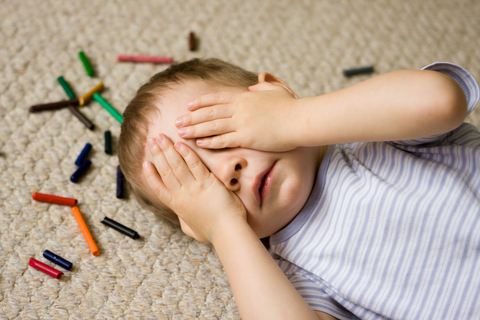-
21 July 2013
-
0 comments

My daughter came to me the other day crying “my crayon broke…I need to throw it in the garbage.” “No,” I replied, “mommy loves coloring with broken crayons!”
As a mother, I understand my daughter’s frustration over trying to use a small crayon to color. When children are young, they like everything to be big and whole. However, as an occupational therapist, I know that broken crayons are often more valuable than whole crayons.
Using small crayon tips and manipulating other small objects help children learn proper grasping patterns. Have you ever tried to color with a broken crayon by wrapping your entire fist tightly around it? Try it! I guarantee it will be easier for you to hold it in between your thumb and index finger or even with 3 fingertips, than to use your entire hand.
If your child, like mine, refuses to use a broken crayon, there are still many ways you can “trick” them into engaging in activities that promote a proper grasp. Below is a list of activities that have the same effect on one’s grasp as using broken crayons:
- Stamping- there is something about kids and stamps that seems almost magnetic. Children love playing with stamps and you will love knowing that they are doing something that is helping to promote healthy development. (Just make sure they only stamp on paper or you could have a big mess to clean up later!)
- Stickers- peeling stickers off the backing and placing on paper
- Finger painting
- Drawing pictures in shaving cream
- Making a tape ball- stick 1-2 inch pieces of tape to a countertop and have them peel the tape off and form a big tape ball.
- Games like Hi-ho cherry-o, making them pinch the cherry stems when placing in tree or basket
- Stringing beads on a pipe cleaner
In a workshop, Foundations for Learning, Kathy Johnson, MS Ed and author of Pyramid for Potential tells that if your child is 5 years or older, there is a simple exercise you can have him do that will work to promote a proper grasp as well. This exercise needs to be done for 60 seconds a day, for 30 consecutive days in order for it to be truly successful. For this exercise, touch the thumb of one hand to the pointer, middle finger, ring finger, and pinky finger, working sequentially, and then go backwards from pinky to pointer. When doing this exercise, make sure to use a light touch instead of pressing the pads of your fingers together tightly. It is also important to make sure that the opening created in between your thumb and the opposing fingertip is round as opposed to a tear drop shape. This should be done 3 times with each hand. Have your child work up to being able to do this exercise with both hands simultaneously; however, if this is too difficult it could be done using only one hand at a time.
Although the reflexes help to ensure a baby develops properly, they need to be integrated into a child’s system to have the desired effect. Primitive reflexes are reflexes that are present in infants and help ensure that an infant moves his body in ways that encourage proper development. There are many reasons why an infant may fail to fully integrate the reflex as a baby. Reflexes that are not fully integrated may have a negative impact on a child’s skills later in life. By performing this exercise religiously, one is working to integrate the Palmar Reflex, which in turn will have a positive effect on his grasping pattern.
Share Social
